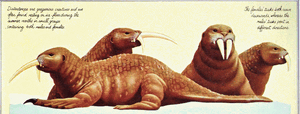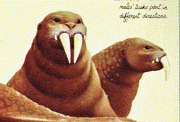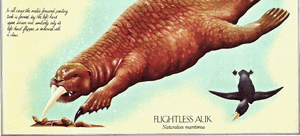
Distarterops are gregarious creatures and are often found resting on ice floes during the summer months in small groups containing both males and females.
The distarterops, Scinderedens solungulus, is a large, semiaquatic relative of the predator rats from the Polar Ocean that looks like a cross between a beaver and a walrus.
Among the organic detritus on shallower areas of the ocean bed of the Polar Ocean are found banks of shellfish. Living on these shellfish is the distarterops, by far the most massive swimming relative of the predator rats. It reaches a length of about four meters and has an insulating coat of matted hair made up of a mosaic of solid plates, giving it a lumpy rather than streamlined appearance. Its most unusual feature is its teeth; the upper incisors form long, pointed tusks (in males, the left-hand one projects forward, whereas the right-hand one points straight down and is used as a pick for removing bivalves from the sea bottom). This asymmetry is also found in the limbs; the left forelimb only is equipped with a strong claw, which it uses to dislodge particularly stubborn shells. Because the distarterop's evolutionary line separated from the predator rat's when they were both still comparatively small rats, it would appear therefore that the predator rat's double-pointed incisor teeth, from which the distarterops tusks (and also the bardelot's sabre teeth) have evolved, were a comparatively early development.

The females' tusks both curve downwards, whereas the males' tusks point in different directions.

In all cases the male's forward-pointing tusk is formed by the left-hand upper incisor and similarly only the left-hand flipper is endowed with a claw.
